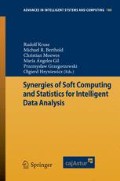Abstract
The ability to associate concepts is an important factor of creativity. We investigate the power of simple word co-occurrence analysis in tasks requiring verbal creativity. We first consider the Remote Associates Test, a psychometric measure of creativity. It turns out to be very easy for computers with access to statistics from a large corpus. Next, we address generation of poetry, an act with much more complex creative aspects.We outline methods that can produce surprisingly good poems based on existing linguistic corpora but otherwise minimal amounts of knowledge about language or poetry. The success of these simple methods suggests that corpus-based approaches can be powerful tools for computational support of creativity.
Access this chapter
Tax calculation will be finalised at checkout
Purchases are for personal use only
Preview
Unable to display preview. Download preview PDF.
References
Blei, D.M., Ng, A.Y., Jordan, M.I.: Latent dirichlet allocation. J. Mach. Learn. Res. 3, 993–1022 (2003)
Bowers, K.S., Regehr, G., Balthazard, C., Parker, K.: Intuition in the context of discovery. Cognitive Psychol. 22(1), 72–110 (1990)
Deerwester, S., Dumais, S.T., Furnas, G.W., Landauer, T.K., Harshman, R.: Indexing by latent semantic analysis. J. Am. Soc. Inform. Sci. 41(6), 391–407 (1990)
Dunning, T.: Accurate methods for the statistics of surprise and coincidence. Comput. Linguist. 19(1), 61–74 (1993)
Forbach, G.B., Evans, R.G.: The remote associates test as a predictor of productivity in brainstorming groups. Applied Psychological Measurement 5(3), 333–339 (1981)
Gervás, P.: An expert system for the composition of formal spanish poetry. Knowl-Based Syst. 14(3-4), 181–188 (2001)
Gross, O., Toivonen, H., Toivanen, J.M., Valitutti, A.: Lexical creativity from word associations. In: Proc. 7th Int. Conf. on Knowledge, Information and Creativity Support Systems (KICSS 2012), Melbourne, Australia, November 8-10. IEEE Press (accepted for publication, 2012)
Hofmann, T.: Probabilistic latent semantic indexing. In: ACM SIGIR Conf. on Research and Development in Information Retrieval, SIGIR 1999, pp. 50–57. ACM, New York (1999)
Manurung, H., Ritchie, G., Thompson, H.: Towards a computational model of poetry generation. In: Proc. AISB 2000 Symposium on Creative and Cultural Aspects and Applications of AI, pp. 79–86 (2000)
Mednick, S.: The associative basis of the creative process. Psychol. Rev. 69(3), 220–232 (1962)
Mednick, S., Mednick, M.: Remote associates test, examiner’s manual: college and adult forms 1 and 2, Boston, MA, USA (1967)
Michel, J., Shen, Y.K., Aiden, A.P., Veres, A., Gray, M.K., Pickett, J.P., Hoiberg, D., Clancy, D., Norvig, P., Orwant, J., Pinker, S., Nowak, M.A., Aiden, E.L.: Quantitative analysis of culture using millions of digitized books. Science 331(6014), 176–182 (2011)
Netzer, Y., Gabay, D., Goldberg, Y., Elhadad, M.: Gaiku: generating haiku with word associations norms. In: Proc. Workshop on Computational Approaches to Linguistic Creativity (CALC 2009), pp. 32–39. Association for Computational Linguistics, Stroudsburg (2009)
Toivanen, J.M., Toivonen, H., Valitutti, A., Gross, O.: Corpus-based generation of content and form in poetry. In: Proc. Int. Conf. on Computational Creativity (ICCC 2012), Dublin, Ireland, May 30-June 1, pp. 175–179 (2012)
Tseng, S., Sue, P., Su, J., Weng, J., Tsai, W.: A new approach for constructing the concept map. Comput. Educ. 49(3), 691–707 (2007)
Wong, W.T., Chun, A.H.W.: Automatic haiku generation using VSM. In: Proc. Int. Conf. on Advances on Applied Computer and Applied Computational Science (ACACOS 2008), pp. 318–323 (2008)
Author information
Authors and Affiliations
Corresponding author
Editor information
Editors and Affiliations
Rights and permissions
Copyright information
© 2013 Springer-Verlag Berlin Heidelberg
About this paper
Cite this paper
Toivonen, H., Gross, O., Toivanen, J.M., Valitutti, A. (2013). On Creative Uses of Word Associations. In: Kruse, R., Berthold, M., Moewes, C., Gil, M., Grzegorzewski, P., Hryniewicz, O. (eds) Synergies of Soft Computing and Statistics for Intelligent Data Analysis. Advances in Intelligent Systems and Computing, vol 190. Springer, Berlin, Heidelberg. https://doi.org/10.1007/978-3-642-33042-1_3
Download citation
DOI: https://doi.org/10.1007/978-3-642-33042-1_3
Publisher Name: Springer, Berlin, Heidelberg
Print ISBN: 978-3-642-33041-4
Online ISBN: 978-3-642-33042-1
eBook Packages: EngineeringEngineering (R0)

